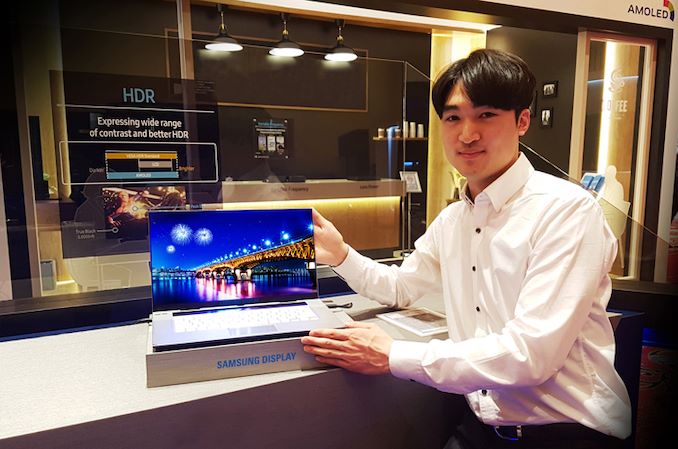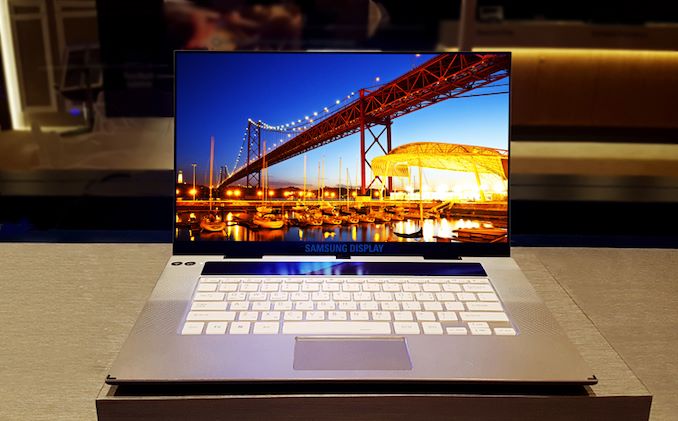Samsung Unveils 15.6-Inch Ultra-HD OLED Display for Laptops
by Anton Shilov on January 24, 2019 12:00 PM EST
Samsung has announced its 15.6-inch OLED monitor for notebooks. The Ultra-HD display features very advanced specs, will go into mass production next month, and will be used by leading makers of high-end notebooks later this year.
The Samsung 15.6-inch OLED monitor for notebooks relies on an Ultra-HD (3840×2160) OLED panel that boasts with a brightness level ranging from 0.0005 to 600 nits, a dynamic contrast ratio of 120,000:1, a very low response time, and wide horizontal viewing angles. The display can reproduce 100% of the DCI-P3 color gamut, which is considerably more more accurate when compared to LCDs available today. Furthermore, the monitor carries VESA’s DisplayHDR True Black badge thus supporting at least HDR10 spec.
| Specifications of Samsung's 15.6-Inch OLED Panel | |
| Specs | |
| Panel | 15.6" OLED |
| Native Resolution | 3840 × 2160 |
| Maximum Refresh Rate | ? |
| Response Time | unknown |
| Brightness | 0.0005 to 600 cd/m² |
| Contrast | 120,000:1 |
| Viewing Angles | ? |
| HDR | DisplayHDR True Black, HDR10 |
| Pixel Pitch | 0.0899 mm² |
| Pixel Density | 282 ppi |
| Display Colors | ? |
| Color Gamut Support | DCI-P3: 100% |
| Aspect Ratio | 16:9 |
| Mass Production Start | Mid-February-2019 |
An added bonus of any OLED monitor are very narrow display bezels, which will enable makers of notebooks to further miniaturize their 15.6-inch class laptops. In the meantime, keep in mind that the OLED technology is not ideal and has its own weaknesses, including off-axis color shifting, ghosting, burn-in, and other. So, only time will tell how good the new display from Samsung is.
Samsung will start mass production of its 15.6-inch OLED monitors for laptops in mid-February, so expect actual notebooks that use the display to hot the market later this year.
Back at CES, Lenovo and HP announced plans to use 15.6-inch AMOLED panels with their premium laptops in 2019, but did not confirm the source of their monitors.
Related Reading
- Lenovo at CES 2019: Yoga C730 Gets AMOLED Display
- HP at CES 2019: HP Spectre x360 15 Gets AMOLED Display
- Dell at CES 2019: Alienware 55-Inch 4K 120 Hz OLED Gaming Monitor Showcased
- New 8K OLED Displays for Tablets and Laptops: 8.3 and 13.3 Inches
- CES 2019: LG Announces Signature OLED TV R - A Rollable TV
- Lenovo Launches ThinkPad X1 Yoga At CES With OLED Display
- JOLED Demos 21.6-Inch OLED Monitor for Gamers
Source: Samsung











38 Comments
View All Comments
ikjadoon - Thursday, January 24, 2019 - link
Oh, come on. Laptop OLEDs have notoriously struggled against traditional LCDs. OLED in laptops is as useless a buzzword as NVMe these days. NVMe is no guarantee of performance; OLED in a laptop is no guarantee of performance.1) Battery life: almost always significantly worse with OLED because the web and most desktop applications have higher APLs.
https://www.anandtech.com/show/10697/the-lenovo-th...
2) Poor quality OLEDs vs high-quality LTPS panels: the LTPS panels win.
https://hothardware.com/reviews/lenovo-thinkpad-x1...
>As you can see, though again the Canon 80D camera even masks some of the detail, the ThinkPad X1 Carbon 6th Gen machine outperforms even the OLED display of the ThinkPad X1 Yoga. This is a major accomplishment in our estimation, as this laptop OLED panel is one of our favorite premium laptop panels to date.
3) Burn-in is absolutely a concern. Lenovo shipped "OLED Panel Management" software with their X1 OLEDs that did...obvious things like dimming the taskbar, setting shorter display timeouts, and dimming your wallpaper.
//
Now, I'm all for newer generations and continuous improvement through design iterations going to market -> feedback -> going to market cycles. But, it's all right to draw the line at OLED.
You should pick the best display you can when you buy a laptop; but "best" doesn't necessarily mean "easy on your eyes". Best can damn well mean "lasts me the whole bloody day."
ikjadoon - Thursday, January 24, 2019 - link
Lenovo's OLED longevity and battery life mitigation software: https://forums.lenovo.com/t5/ThinkPad-X-Series-Lap...p1esk - Thursday, January 24, 2019 - link
You forgot PWM, which for some is the biggest problem with OLED screens.https://blog.elcomsoft.com/2018/10/iphone-xs-pwm-d...
MarcusMo - Friday, January 25, 2019 - link
PWM is not an OLED necessity. It all depends on implementation. The galaxy s9 uses PWM dimming for anything less than 100% brightness. The iPhone XS on the other hand does not use PWM above 50% brightness.At a certain point you’ll have to choose between uniformity and flickering. OLEDs driven at a low current will exacerbate any manufacturing variances, yielding weird patterns and artifacts.
Given this, I think apples approach is a decent compromise. Using PWM all the way isn’t. It reeks of laziness.
We’ll see what dimming method the implementations of this display will use, but I’m not getting my hopes up. In all likelihood, they’ll use it in the cheapest possible way, while still being able to slap the “4k HDR OLED” lable on it.
ajp_anton - Thursday, January 24, 2019 - link
The high APL is a bad argument, because with LCD's, the APL is basically always 100%, because the backlight lights up everything. In fact, it's 200%, because the polarization filter automatically removes half the light, always.What you should say instead is just that OLED is a lot less energy efficient as a light source as the LED's used as the backlight in most LCD's. And I'd like to have an explanation on why this is... Maybe Micro-LED will fix this problem?
MarcusMo - Friday, January 25, 2019 - link
I’m certainly no expert, but my guess as to why leds are more efficient than oled is that of all scalability; a few big light sources are more efficient than millions of small.ikjadoon - Tuesday, February 19, 2019 - link
Sorry; Anandtech doesn't have notifications for comments.APL is a software methodology measurement (% of the screen displaying white)...it's not related to the display technology. The Web has a high APL (since most websites use white or white-ish) backgrounds. 50% APL means roughly half the screen is white. If your use-case is high APL, a comparable OLED vs LCD matchup will show the LCD with much longer battery life. Anandtech has tested this (see their Lenovo X1 OLED reviews).
The explanation, grossly simplified: to display colors, LCDs re-arrange their crystals to "transparent" so the white backlight shines through. LCDs don't change battery life depending on the color displayed. It's always the same power.
OLEDs, instead, light individual subpixels (often RGB) and thus different colors have different power consumption. Displaying red uses only 1 subpixel, while white requires 3 subpixels. That means displaying pure RGB colors use roughly 1/3 the power, displaying white uses all the subpixels and all the power, and displaying black uses no subpixels and greatly reduced power.
The unfortunate reality: 3 subpixels on OLED consume more than 1 pixel on LCD. So if you just displayed an all-white screen, OLED would murder your battery (like, 50% shorter battery life, if not much more)
This explanation is grossly oversimplified, but it works. (FWIW, LCDs also use subpixels, but they're not individually lit, so they all get lumped together for power comparisons).
ikjadoon - Tuesday, February 19, 2019 - link
MicroLED fixing the issue: only if 1 pixel's worth of microLEDs use less power than one LCD pixel when displaying white (white is the worst for all emissive technologies, IIRC, as white requires all subpixels/microLEDs to be on).Say 9 microLEDs power a single pixel on a microLED display. To display white, it'll need to power all 9 microLEDs. Each microLED here would need to use less than 11% power of a full LCD pixel (who can display white, green, purple, etc. at a constant power rate).
I'm all for microLED taking over; hopefully, Samsung et al. release them ASAP. OLED sorely needs competition to drive down pricing!
kaidenshi - Thursday, January 24, 2019 - link
> "Has that ever been a problem? Millions of phones would say, "no.""And millions more said "yes". The Samsung S4 Active was a big one; that screen ended up with taskbar burn-in within weeks of first use. Several HTC One SKUs with OLED screens suffered similar fates.
OLED has improved, but the fact that in 2019 Lenovo has to ship software to mitigate burn-in on their OLED equipped laptops speaks volumes.
If you're going to shill, at least try to do your homework first.
piroroadkill - Friday, January 25, 2019 - link
Always. ALL OLED phone screens I've seen have exhibited signs of degradations. Just because you're not looking at it, doesn't mean it doesn't happen.